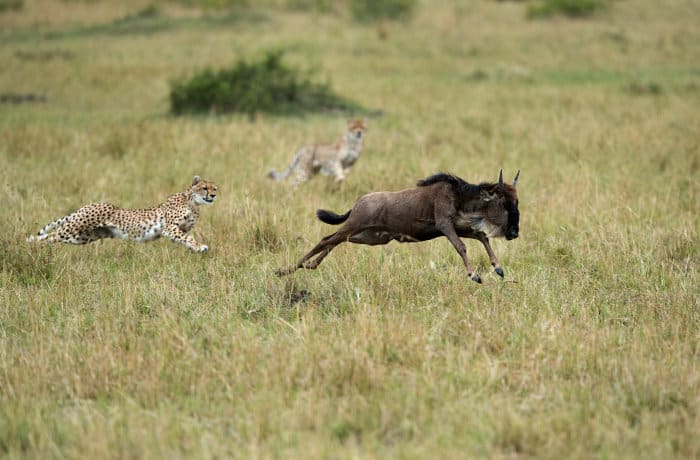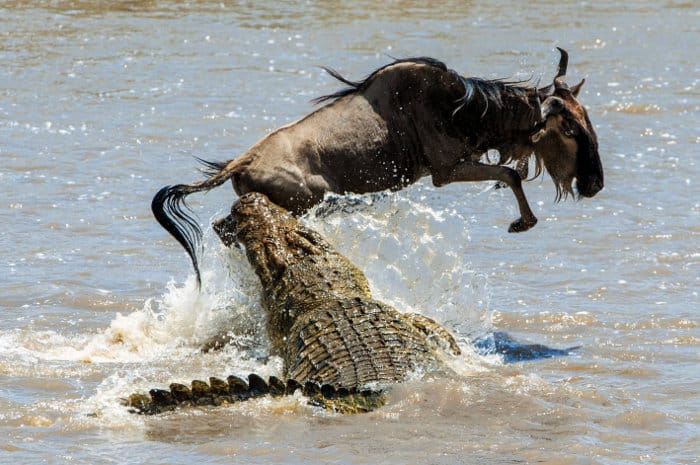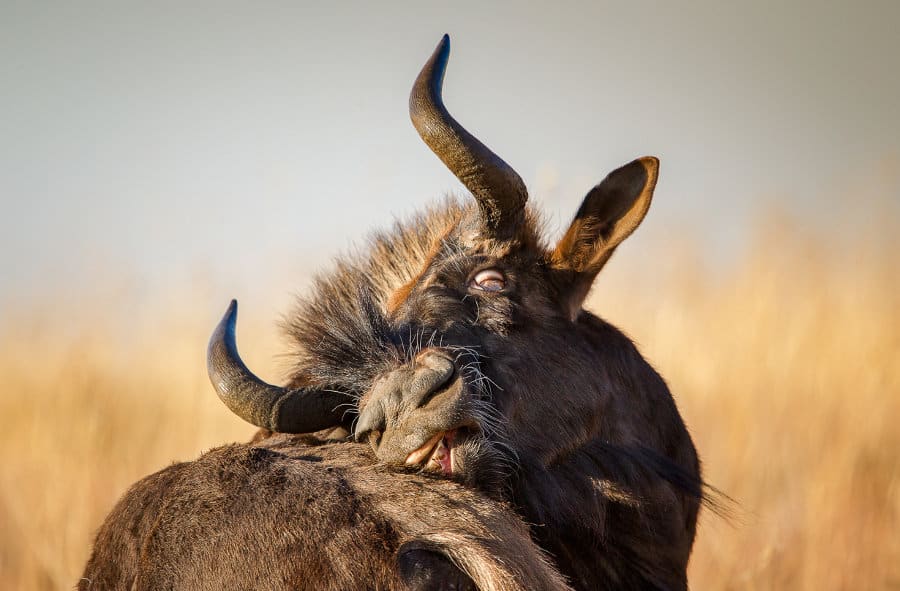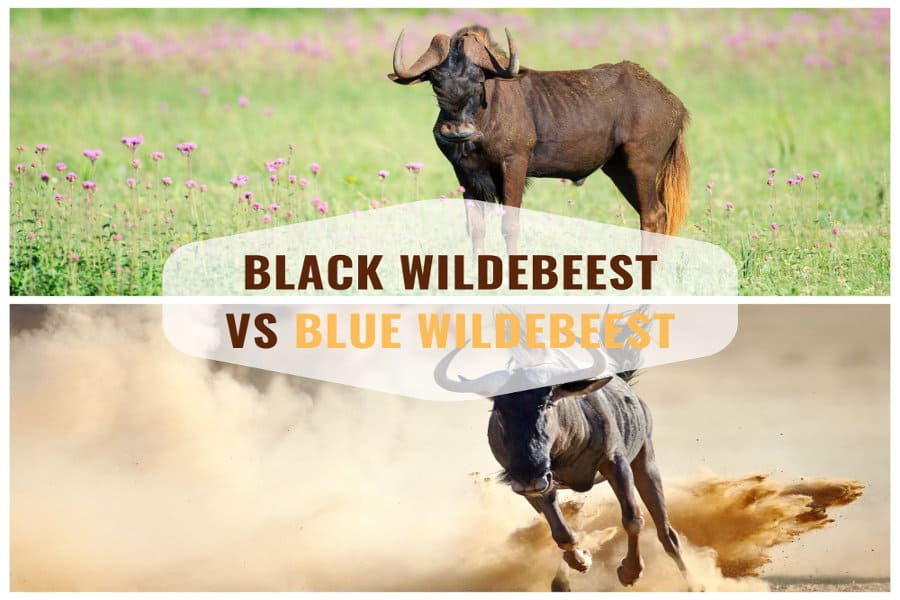Wildlife documentaries struggle to make the great wildebeest migration seem real.
The camera pans out to reveal over a million mammals. Close ups show lion prides salivating at their dinner menu. Crocodiles maul zebra with ferocious abandon.
Every year, around two million mammals make their incredible journey around the Serengeti and Masai Mara. The grass disappears beneath a carpet of rumblings hoofs and stealthy paws. It just never seems real. But it is.
The great wildebeest migration is the greatest movement of wild mammals anywhere in Africa. Go to East Africa on a safari and you’ll probably be asking – “will I see the migration?”
Two million animals don’t vanish. Nor is there a month when the lions and wildebeest call a truce. So whatever time of year you go on safari, you can see the migration. It’s all about being in the right place at the right time.
This article explains where you need to go at different times of the year, and dispels some of the myths about this incredible phenomenon.
The Basics of the Great Wildebeest Migration

What is the great wildebeest migration?
The annual and circular migration of over 2 million wildebeest, zebra and Thomson’s gazelle around the grasslands of East Africa. It’s the greatest movement of land mammals anywhere in Africa.
How many animals make up the great wildebeest migration?
Nobody is sure of the exact numbers but estimates suggest around 1.5 million wildebeest, half a million zebra, along with significant numbers of hyena and Thomson’s gazelle.
Where does the great wildebeest migration occur?

This phenomenon takes place in the Serengeti ecosystem, in East Africa. The moving herds will spend around nine months in Tanzania and three months in the Masai Mara, Kenya.
See these articles on Kenya safari and Tanzania safari.
Why do the animals migrate?
All these animals are grazers that feed on grass. Their migration pattern follows the rains, allowing them to continually feed on fresh pastures. They eat as they travel and don’t have a final destination – the animals just keep moving and grazing.
Do lions follow the wildebeest?
No. Most predators do not have the stamina to follow the herds. The big cats must also protect their home range. So contrary to preconceptions, the wildebeest aren’t followed by leopards, cheetahs or lions. Instead, they wait for the feast to come to them.
Hyena can follow the migration, although not all do. They are usually territorial animals. However, hyena will allow rivals to pass through their territory, as long as they do not hunt or provide competition.
African vultures are the other predator that actually follows the migration.
What is the Mara River crossing?
As part of their migration, the wildebeest must cross the Mara River to reach the Masai Mara. This is the famous Mara River crossing, with open-jawed crocodiles waiting to feed on the slow, sick and weak (plus all those who drown as well!).
This is the most famous moment of the migration. Wildebeest gather in large groups before one strong and brave animal makes a charge. All the others follow. A few days later and new groups of wildebeest gather to make their crossing.
Month by Month Safari Guide – The Great Wildebeest Migration

A great wildebeest migration safari is all about being in the best place dependent on the month of the year. Much of the Serengeti and Masai Mara lay empty. Then you cross a ridge and suddenly encounter half a million animals.
January to March – Calving on the southwestern Serengeti plains

This is the best time to see predators and the best time for a budget safari.
This incredibly journey starts (or ends 🙂 ) with the wildebeest having their calves on the nutritious grasslands of southwestern Serengeti. Close to 2 million animals blanket the panorama.
Here, the volcanic soil is incredibly nutritious, so the wildebeest can develop at double the speed as those in other places in Africa. This landscape is due west of Ngorongoro. When Ngorongoro exploded it sent mineral-rich ash westwards onto the Serengeti, while also creating the world’s largest intact volcanic caldera (Ngorongoro Crater, another wonderful safari destination).
So the wildebeest come here to have their calves. The calves spend two to three months fattening up on the lush grass, until they’re strong enough to make their journey.
And the predators lick their lips. With so many newborns around it’s very easy for them to get a meal. Resident cats also want to give birth at this time of year, when food is most abundant.
* Planning a Safari
This part of the Serengeti is closest to other destinations on Tanzania’s Northern Circuit. It’s the easiest and cheapest place to visit in the Serengeti. Just go on an overland safari from Moshi or Arusha, making a stop in Ngorongoro on the way (you can also add in Tarangire and Lake Manyara to make this a longer safari).
Park fees are expensive and you pay per 24 hours. The cheapest safaris offer 24 hours in the park – aim for at least 48 hours. A safari is more expensive later in the year because you must drive further into the Serengeti before encountering the herds (which takes more time so is more expensive).
At this time of year you should witness wildebeest (and maybe zebra) giving birth. You should also experience a hunt, hopefully multiple live hunts.
In Serengeti National Park you are not usually permitted to drive off the trail. The exception is in southwestern Serengeti as the grasslands are seasonal and have nine months to recover.
So rumble off the trail and get close enough to hear the resounding crack of lions biting into a zebra carcass. Or follow a leopard dragging a wildebeest towards a tree. Or get just metres away from cheetah cubs.
April to July – Crossing the Serengeti

2 million animals don’t move in one group. From late-March onward they start marching in large herds. These form super herds. Usually there are between seven and ten of these super herds, with the largest numbering up to half a million animals.
April and May is East Africa’s main rainy season. Long rains stimulate the Serengeti grasslands and in some areas the grass grows over a metre in height. Rather than charging north it takes three to four months for the animals to reach the Mara River.
Hectic scenes unfold. You hear the thundering of hooves and the grunt of resident lions. Wildebeest space out in order to graze, with the herd sometimes stretching five miles across. Typically the animals are energetic and very photogenic during the mornings, but travel slowly through the afternoon.
Rutting is a daily occurrence. Male wildebeest will buck their legs and clash heads with rivals. In a cloud of dust the stronger male forces his opponent backwards, then gallops off enthusiastically. Battles are short yet numerous. Strong males will also gallop short distances, showing off their fitness and suitability as a mate.
In comparison, zebra huddle close together, in a tightly packed formation of black and white stripes. They are usually two or three days behind the wildebeest.
* Planning a Safari
Most great wildebeest migration maps show the animals traveling through the Western Corridor and an area known as Grumeti. This is not entirely accurate.
Each super herd makes its own path north. They do not follow each other because they must each find their own fresh grass. Some of these herds travel west and then north (usually these are the first herds to set off). Others go straight through the middle. Later herds take a more direct path north. And all this is dependent on the exact timing of the rain.
When planning a safari during these months it’s essential to stay flexible. Good safari companies will keep their accommodation options open. The Central Serengeti is a safe choice. A mobile camping safari is the best choice as these camps move with the herds – however, this is very expensive.
Go for at least 72 hours in the Serengeti. You’ll want to immerse yourself in all the nuance and action. With an overland safari it will take around three hours to reach the Central Serengeti from Ngorongoro (and three hours to leave). A fly-in safari maximises your time on the ground but is more expensive.
Expect to see an abundance of predators, although most of the actual hunting takes place after dark. You can only go on daytime game drives that stick to the trails.
Note that some trails become inaccessible due to the rain. Whole sections of the Serengeti turn to mud, especially from mid April to mid May. Some of the camps close for these months. June is usually a safer choice.
July – August – Mara River Crossing

Fresh grazing lands lie north of the Mara River, in the Masai Mara. To reach them the wildebeest must cross a crocodile-infested river, with lions lurking on both banks. It’s dangerous and dramatic!
This could be the biggest African safari anticlimax. It’s an incredible spectacle. But…the wildebeest only cross every three to five days, so you could spend three days waiting by the river with nothing happening.
Plus, this famous scene is incredibly popular. Many dozens of safari vehicles line up to watch the show, somewhat detracting from the charm. And while you’re waiting around, you could be witnessing so much more elsewhere.
The Mara River is a natural divide between the Serengeti (Tanzania) and Masai Mara (Kenya), although most of the river is actually in Kenya. Not all wildebeest make the crossing. Some stay behind to graze in Northern Serengeti while others choose the fresh Mara pastures.
* Planning a Safari
1) Kenya
A Masai Mara safari is more popular as it can be cheaper. However, note that most camps and lodges are over a two-hour drive from the river. It’s worth splurging for a camp that’s actually on the river, or at least one in the Mara Triangle.
You can fly or drive from Nairobi to the Masai Mara. Three days two nights in the park is recommended. Even then, don’t expect to see the Mara River crossing. You need some luck and there’s so much more than this one dramatic scene.
2) Tanzania
Northern Serengeti is difficult to visit on an overland safari – it’s just so far away from Arusha and you must cross the national park twice (going there and back). A better and sometimes cheaper option is to fly in.
While the Masai Mara gets crowded with budget safaris, you can have the Northern Serengeti almost to yourself.
The other advantage is that you’re guaranteed to encounter large herds. The wildebeest gather in Tanzania before the crossing. So even if they don’t cross the river you are still surrounded by animals; in the Mara you must wait for the animals to come to you.
August to October – The great wildebeest migration is mostly in Kenya’s Masai Mara

Many of the animals make it over the river and they now graze in the Masai Mara. Once in Kenya they disperse and you’ll find clumps of animals in all corners of the park. They are no longer migrating in super herds but spreading out into smaller herds.
All the cats have been waiting for this and these months offer incredibly intimate encounters, including many raw predator versus prey scenes.
* Planning a Safari
To really connect with your wild side we’d recommend a Masai Mara safari in September or early October. August is very popular and the Mara is much smaller than the Serengeti; it struggles to absorb the dramatic influx of visitors.
Waiting a month means you’ll definitely miss the Mara River crossing. But not only are there fewer safari vehicles at this time, visitors are more dispersed across the park.
Consider a four-day safari, mixing two days in the main national reserve and two days in a private conservancy. In the conservancy you can drive off the trails, safari at night, and even go on a game walk in lion country.
November to January – Dispersed through the Serengeti

Over 2 million animals start the journey but by now the numbers are dwindling. Crocodiles ate some. Lion prides have fattened up for the barren months to come. Hyenas have ravaged the sick and weak.
Now the wildebeest and zebra must return to their calving grounds. They travel in loose straggly herds, mostly through the east of the Serengeti and an area known as Loliondo.
From December onward the wildebeest are back in Southeastern Serengeti, but this really depends on the rains (sometimes it’s not until late January).
* Planning a Safari
This is an off peak time to visit and you can find good deals on camps and lodges. Although you won’t see the big migrating herds, there’s always drama when so many ungulates pass through lion and leopard territory.
Anywhere central or eastern is a safe choice but it’s worth staying flexible. On an overland safari you enter in the southeast and need at least 48 hours to ensure you can travel far enough to view the herds.
Amazingly, the wildebeest have their calves and mate at the same time. So in these months you’ll witness lots of rutting. Many of the animals are weary from their journey. Stronger bulls will look to assert their dominance so they can mate with as many females as possible.
Tips for Experiencing the Great Wildebeest Migration

Climate change
It’s important to remember that the wildebeest don’t follow a Western calendar. Their journey is dictated by the rains and climate change has made these increasingly unpredictable.
East Africa typically follows a pattern of dry seasons and rainy seasons. The wildebeest follow these rains, grazing on fresh grass as they go. If the rains come earlier or later this will impact the movement of herds.
There is more to the Serengeti and Masai Mara than the migration
This ecosystem is home to more wild mammals than anywhere else in Africa. Both the Serengeti and Masai Mara offer inspiring experiences every month of the year. And remember, the big cats don’t follow the herds, so these can be seen all over the parks at all times of year.
Don’t be too hung up on seeing the great wildebeest migration. Make sure you actually go on an African safari, rather than trying to marry a perfect month in Africa with the month you can go on safari. Just go. You will be inspired. It will be a remarkably intimate and authentic experience.
Planning a safari

Africa Freak has a partnership with a boutique safari company who will customise a journey to your interests and timeframe. You can start the conversation by clicking here.
You can also plan a safari with any of the hundreds of operators in Tanzania and Kenya. Ask them the difficult questions before making a booking, testing their knowledge of the great wildebeest migration.
The best safari operators will want to stay flexible about where you go, rather than stick to a fabled map of migratory routes. This is an ever-changing phenomenon and it is local, up-to-date knowledge, that will get you closer.



